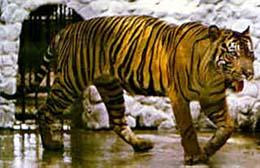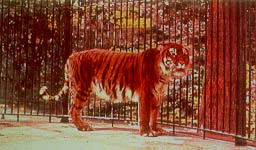 |
 |
 |
|||||||||
| Bengal | White | Siberian | |||||||||
 |
 |
 |
|||||||||
| Bengal | White | Siberian | |||||||||
 |
 |
 |
|||||||
| Sumatran | Indo-chinese | South China | |||||||
Bengal Tiger
The Bengal tiger, or the Indian tiger, may reach the same length as the Siberian tiger, but it is less massive and its coat varies from light yellow reddish-yellow with black stripes. Some of them can get extremely large (the largest was 10 feet, 7 inches and weighed 491 pounds), which is because these ones are cattle-killers and consequently very bulky. The average adult male bengal tiger is 9 feet, 3 inches and weighs 420 pounds. The Bengal tiger has the worst reputation among the tigers as man-eaters, but it is estimated that no more than 3 out of a thousand tigers actually attack humans. Usually, they will only kill humans if they are very old or injured and can't catch their usual prey.
White Tiger
White tigers are not true albinos since their eyes are blue, not pink, and their stripes are either brown or black. The white color is a recessive gene. White tigers first sprang up from "Mohan", a tiger that was caught when she was nine months old, but now there are at least three other strains of white tigers. White tigers have occasionally been glimpsed in the wild, but usually they are only seen in reserves and zoos. They are extremely rare. They are the same size as the Siberians.
Siberian Tiger
The Siberian tiger, also known as the Amur, Korean, or Manchurian tiger, is the largest of all cats. A Siberian tiger that was killed in 1934 weighed 771 pounds. Some captive Siberians have weighed up to 800 pounds. Siberians have distinctively pale coats carrying brown rather than black stripes. In the winter, the coat gets very long and shaggy. its muzzle is broader than that of most tigers. Also, as with all tigers, the males get larger than the females. Between 1974-1976, 150 Siberians lived in northeastern China. Sadly the number declined to 30-50 tigers due to poaching and habitat loss. It is doubtful that any wild Siberian tigers remain alive in North Korea. The Siberian is the most well-represented of the tigers in the world's zoos, and in addition to 250-300 still in the wild, there are approximately 665 alive today in the North American and European zoos, with an unknown number in the Asian zoos.
Sumatran Tiger
Sumatran tigers are smaller than the Bengal tiger and have reddish-yellow fur with white areas. The stripes are black, long, and often double. In 1978, there were about a thousand left on the Indonesian island of Sumatra.This has been reduced to 300-450 in the wild. The problem is that the nearby island of Java has about 110 million people, and every year Sumatra receives about 600,000 people from Java. It has been estimated that Sumatra has lost 65 to 80 percent of its forests.
Indo-Chinese Tiger
This race became a separate subspecies as recently as 1968. It ranges from the Irrawaddy River of Myranmar eastward through Thailand, south to peninsular Malaysia, north to Indochina, and into southern China. It is smaller, darker, and less boldly striped than the Bengal. There are about 250 in Myanmar, less than 200 in Thailand, and 500-600 in Malaysia.
South China Tiger
The South China tiger is generally regarded as the stem tiger; it is also smaller than the Bengal, with less extensive white areas underneath and stripes that are shorter, broader, and less numerous. It once lived throughout central China, mainly south of the Yangtse. In 1949 there were four thousand Chinese tigers. About a thousand were annihilated in the 1950-1960 governmental "antipest campaigns". Numbers declined to 150-200 by 1982, and there are only about 30-40 left in the wild today. There are approximately forty South China tigers currently in Chinese zoos.
EXTINCT SUBSPECIES
 |
 |
||||||
| Caspian Tiger | |||||||
| Javan Tiger | |||||||
The Bali Tiger is also extinct, but there are no pictures of them.
When they became extinct
|
Javan
|
Bali
|
Caspian
|
|
1975
|
1970
|
1985
|
The Bali and Javan were two very small subspecies with males averaging only around 200 pounds and darker than the Sumatran. The Javan had close-set stripes while the Bali had fewer stripes and were the darkest of all the tigers. The Caspian tiger was the same size as the Bengal, and its coat was similar, only the stripes were lighter, longer, more narrow, and set more closely together. The last wild Bali was killed in 1937, by 1963, there were only 3 or 4 left in the reserves. They have not been seen since 1970. The Javan was abundant in the 1930s, but by 1955 there were only 20-25 left on Java, of which 10 were in the reserves. During the 1960s, the reserves were exterminated. The Java have not been seen since 1975. The Caspians were the westernmost tigers, reaching all the way to eastern Turkey and inhabiting vast stretches of territory in Iran, northern Iraq, Afghanistan, and both sides of the Caspian Sea. They have not been seen for fifteen years.